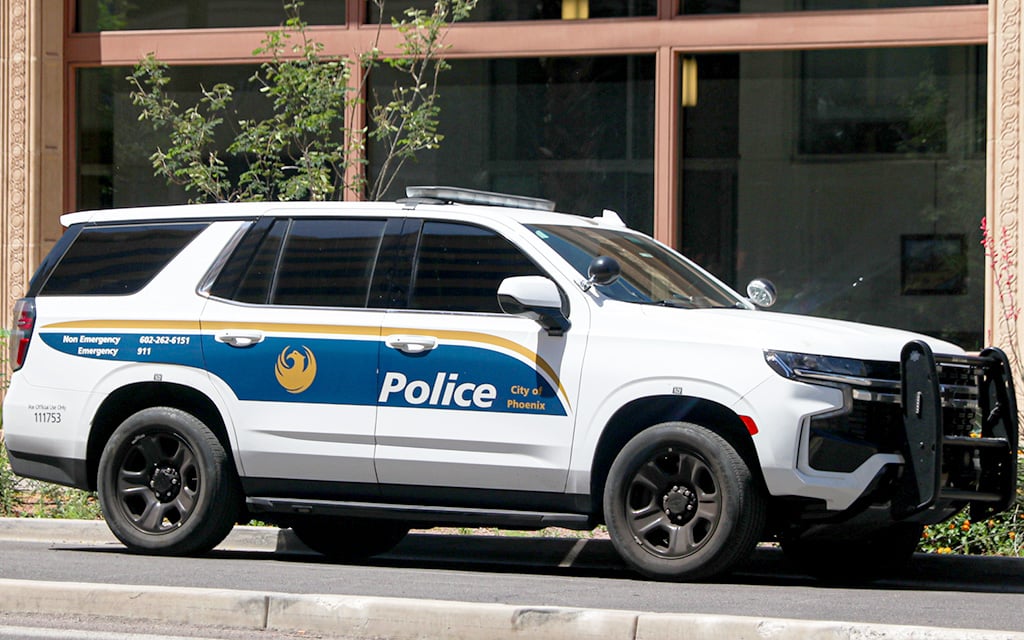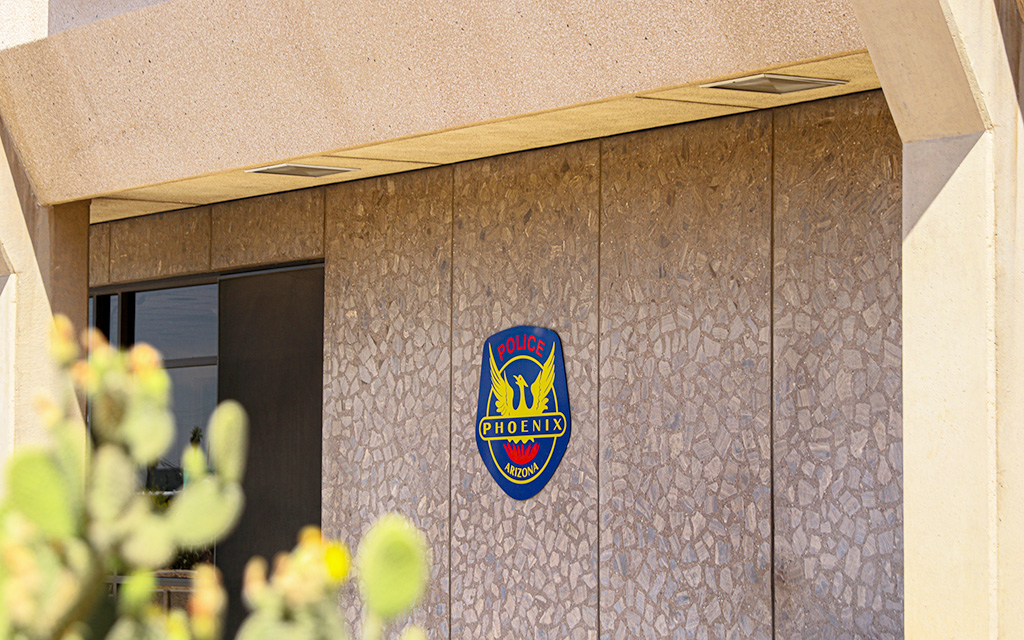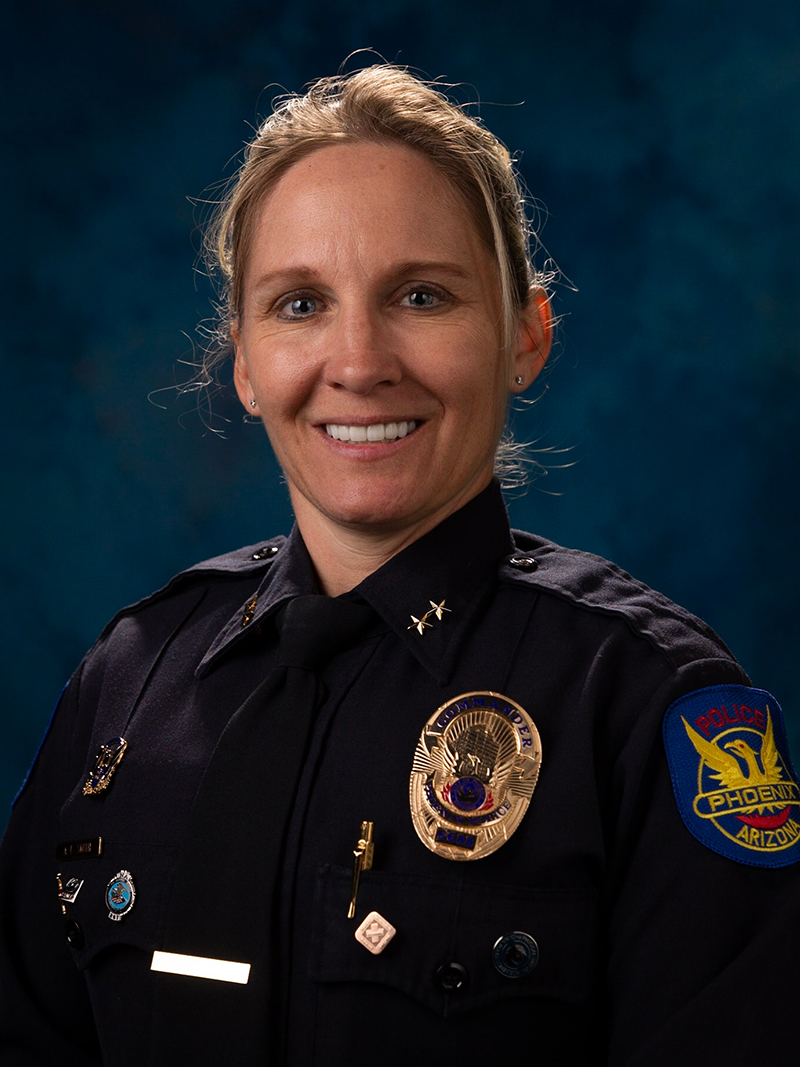- Slug: BC-CNS-Female Police,1410 words.
- 3 photos available (thumbnails, captions below).
By Abigail Scott
Cronkite News
PHOENIX – The Phoenix Police Department is seeking more female police recruits and is working to make sure 30% of its officers are women in the next seven years.
But so far, progress hasn’t been quick or easy.
“We want to look like our community,” said Phoenix Police Cmdr. Aimee Smith, who was instrumental in getting the force to sign the 30×30 Initiative, a national effort to advance women in policing. “That makes us a more inclusive police department, that makes us better crime fighters, that makes us represent our community better, and so this was a way that we can get there.”
The department signed the pledge in January, joining more than 275 city and university departments across the country. The initiative is based on research that more women in policing can lead to better community outcomes, including fewer lawsuits and fewer incidents of excessive force.
The gender makeup of Phoenix’s department is just above the national average, with women currently accounting for 14% of its sworn officers. Nationally, women make up 12% of police officers and 3% of police leadership, according to 30x30initiative.org.
Even with the new efforts nationally, and a Phoenix police salary among the highest in the state — recruits start at $68,661 per year — increasing the number of female officers hasn’t been a straight line. Over the last five years, the Phoenix Police Academy has seen a decline in the percentage of female graduates. In 2018, 22% of the academy’s graduates were female. In 2019, female graduates were just 19% of the class, and women made up only 16% of the graduating class in 2020. In 2021, following the pandemic, women were 20% of the graduating class, but that fell to only 13% in 2022, according to numbers from the academy.
One hurdle to recruiting women may be a police officer’s hours, said Sgt. Melissa Soliz, with the department’s office of public affairs.
“Police officers can work 24 hours, so not the traditional schedule, and this schedule can be challenging for anyone,” Soliz said in an interview.
Michael Scott, director of the Center for Problem-Oriented Policing at Arizona State University’s Watts College of Public Service and Community Solutions, agrees it won’t be a snap to address decades of inequities.
“In the United States, we really began seriously thinking about hiring women to be fully sworn general service police officers in 1980,” Scott said, adding he believes if current female officers enjoy their jobs and feel supported, that could lead to an increase in women in the field.
“When a woman is in an organization and is having a good positive experience, they are more likely to tell other people, including other women, ‘Hey, this is not a bad job,’” Scott said.
Like Smith, Scott believes that having a department that reflects the community is important, and having people from different backgrounds and with different perspectives will strengthen the department and how it responds to emergency situations.
“There is some evidence that female officers might be less inclined to use aggression and force, but not tremendously different, but they use it as needed,” Scott said.
He added, “What has happened in so many incidents in which police use of force was so outrageous, so aggressive, so violent, it’s very seldom to see female officers a part of that.”
The Tempe Police Department signed onto the 30×30 Initiative in 2021.
“Over the last five years, of new officers to be hired, 16% have been females,” said Glorianna Sauer, acting supervisor of the Tempe department’s recruiting and hiring unit.
Sauer said the department saw some success from modifying the language used on pamphlets and in speeches to be more inclusive and encourage more women and minorities to participate in the recruitment process.
Tempe also focuses on not only hiring more female officers but retaining them, she added.
“Different departments have different cultures, and the way they interact with the community and each other can differ,” Sauer said. “I think Tempe does a good job with how we interact with the public and how we treat each other, and this is important for women in the organization to feel supported and to feel valued.”
The 30×30 Initiative does offer specific tips for police departments about things that help, including things like providing space and accommodations to nursing moms who join the force.
“Most of our facilities have nursing rooms for mothers, and that was a big draw for me, knowing I would have nursing rooms here in my building and having a private place to pump and store milk for my newborn at home,” Sauer said. “That is a big deal.”
Sauer said Tempe police believe they will be able to reach 30% by 2030, in part because so many women currently hold traditionally male-dominated positions in the department.
“We have an interim chief who’s female, an assistant chief who’s female, our SWAT commander is female, and we have a huge representation here that other departments don’t usually have,” Sauer said.
The Mesa Police Department is also part of the 30×30 Initiative — which has been signed by other local departments, including Apache Junction, Gilbert, Queen Creek, Tucson and both the University of Arizona and ASU.
Mesa was one of the first 25 departments to sign onto the 30×30 Initiative, and currently 8% of the department’s sworn leadership is female, far exceeding the national average of 3%.
“From 2017 to 2023, there has been a 12% increase in female officers, and female recruits make up 20% of the current 2023 Academy Class #54,” said Tara Hall, the Mesa department’s community relations and recruitment division administrator, in an email.
Mesa continues to advance its program by implementing tactics that have proven effective at recruiting more women. The department offers medical benefits for life, is working on implementing alternative work schedules or part-time officer positions and is creating around-the-clock daycare to help those who have children.
“It’s important to make sure we show that we care about our employees,” Hall said.
In Phoenix, Smith is getting feedback from current female officers to see how the department can be more successful recruiting more women to the profession.
Officers have to be at least 21, U.S. citizens with a clean record (no felonies) and a high school diploma, GED certificate or higher. The department pays for applicants to attend the police academy, where they must pass a physical test and will get legal, weapons and other training, a process that can take several months before applicants can graduate from the academy.
“So one of the first things we’re going to do is send out a survey to all of our sworn female officers in the department, and we’re going to start hearing from them and getting their feedback,” Smith said. “I really want to hear from the officer that has a year on or two years on and say, ‘What is a tactic or what is something that we can use that would hit a different generation of women coming in the door?’”
Understanding and looking at current female officers’ stories and seeing their path to success will help the Phoenix department analyze recruiting tactics that have worked for women in the past and are shown to be successful.
“There is a lot that we give back to the community,” Smith said. Reflecting the community is important for its safety and well being, she said.
“There are a lot of times that the perspective that I bring into a room, I bring into a domestic violence situation or I bring into a scene as a female, automatically starts to calm the situation,” Smith explained.
“I think females need to realize how important they are, because it’s not just what the police do, it’s who is policing us,” Smith said.
Smith encourages women to put themselves out there and do a ride-along with an officer if they are interested in joining the force. “I’m going to steal the elite Nike slogan and say, ‘Just do it,’ it’s exciting,” Smith said.
The Phoenix department is not only focused on gender but also on diversifying the entire department to better reflect its community. “It’s not just gender diversity, we need to look like our community across all our communities,” Smith explained.
Soliz also believes the best way to determine if becoming a police officer is the right fit is to do a ride-along.
“Do a ride-along, talk to someone, don’t be discouraged,” Soliz said.
For more stories from Cronkite News, visit cronkitenews.azpbs.org.
^__=
The Phoenix Police Department is seeking more female police recruits and is working to make sure 30% of its officers are women in the next seven years. (Photo by Gianna Abdallah/Cronkite News)
The gender makeup of the Phoenix Police Department is just above the national average, with women currently accounting for 14% of its sworn officers. (Photo by Gianna Abdallah/Cronkite News)
Phoenix Police Cmdr. Aimee Smith was instrumental in getting the department to join the 30×30 Initiative, a national effort to advance women in policing. (Photo courtesy of Aimee Smith)


